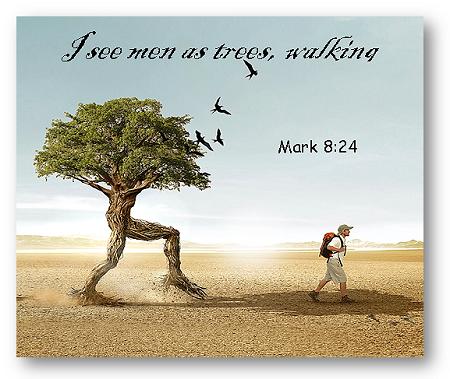Mark 8:22-26 - The Miracle of Christ: Healing in Stages
Mark 8:22-26 - The Miracle of Christ: Healing in Stages
Read Mark 8:22-26

During His ministry, Christ healed many who were blind (see Matt. 9:27-31; 11:5; 15:30; John 9:1-3, etc.). Isaiah had prophesied that when Messiah came, that is what would happen: “Then the eyes of the blind shall be opened” (Isa. 35:5). This would be true literally and spiritually.
Spiritual sight is the point of this particular miracle. Mark is the only one that records the miracle; he does so in context of the disciples’ impoverished notions of who Christ is. A chapter back, Christ lamented, “Are ye so without understanding also? Do ye not perceive...?” (Mark 7:18). And in this very chapter, Christ probed: “Perceive ye not yet, neither understand?” (v. 17). They should have said, “We see men as trees walking” (v. 24).
We know what it is like in everyday life to move from complete darkness to blazing light. Let’s say you are in a room with the shades drawn and the lights out. You stumble to find the doorknob, you open the door, and in floods not only artificial light but also the light of the sun shining through your slider door and reflecting in full strength off the freshly fallen snow. Imagine how your eyes would ache! Similarly, if Christ were to give a full view of who He is, all at once, we couldn’t bear it. He didn’t give His disciples a full sight of Himself all at once, but rather with flashes of glory. Let’s look at this process in the healing of this blind man.
Seeing Nothing⤒🔗
This miracle took place outside the city of Bethsaida, near where Christ had multiplied the loaves for the five thousand. This was on the east side of the Sea of Galilee, near where the Jordan flows into the lake. He had withdrawn as He was preparing for His suffering and death at Jerusalem. But people heard He was there, and brought a blind man to Him, asking for healing.
There are many today who are spiritually deaf, dumb, and blind. They are carried along by others. Perhaps they feel their way to houses of worship; they warm the pews; they do their part and yet don’t see anything of the beauty of Christ, the glory of God, and their need of a divine work on them. The cross is an empty phrase; the hereafter, a hollow concept. What do they need?
They need to be taken apart. As He did to the man who was mute (Mark 7:32), Christ took this blind man apart as well (Mark 8:23). Many “miracle-workers” today want to do their miracle before masses of people, on stages and across televisions of the world. Christ had a far different reason for doing miracles, namely, to reach where no one can see, into the hearts of people, giving spiritual sight. Christ would not have His miracle be a distraction, nor did He want to engender feverish excitement. He would work quietly, unobserved by fickle multitudes. That is still true today.
However, at least the people had this right: they took their blind friend to Jesus. There is no other place to take those who are spiritually sightless but to the One who opens the eyes of the blind.
Seeing Men as Trees Walking←⤒🔗
Christ could have healed the blind man with a simple word or even without it, as He did the woman who touched the hem of His garment. However, He wanted to use this miracle to teach the lesson we are focused on in our study. So Christ led him out of the town (v. 23). Likely, His disciples accompanied Him.

First, He spat on his eyes (v. 23a). Why did He do this? We know that He used this means more often (see Mark 7:33; John 9:6), but we can’t be sure why. Certainly, it was not because there was some magical quality to it. It proves that what may appear repulsive to us at the first may serve our great good. God can use the Bible that unbelievers despise to save them. He can use lowly fishermen to convert thousands. He uses a reprehensible cross to give life to dead souls. God glorifies His own great power by the despised means He chooses to use.
Second, He put His hands on him (v. 23b). Jesus had already touched the man when He had led him out of town. But now “he put his hands upon him,” probably the eyes themselves. He was communicating with the man in a way he could understand, by touch. Moreover, He identified the problem area for the man. He does the same thing when, through His Word, He put His hands on our stony hearts. He has a way of putting His finger directly on the problem.
Third, He asked a searching question (v. 23c): “He asked him if he saw ought.” He didn’t ask the man how he felt or if he had had an experience. He didn’t ask him if he had any opinions he cared to share. He asked him if he saw. The true test of whether the Lord has done a work on us is whether we can see anything spiritually. Can we see our guilt? Can we see His glory? Can we see His mercy? What is your answer to Christ’s question? Have the scales fallen off your eyes?
It is worth noting that Christ didn’t ask the man whether he saw, but whether he saw “ought,” that is, “anything”? Christ, of course, knew what He was doing; for the sake of the disciples, Christ wanted this man to put into words his partial sight. And so this man used a very interesting picture: “I see men as trees, walking” (v. 24). He really couldn’t tell people and trees apart, except for the fact that he knew trees didn’t walk and people did.
Let’s be honest as we answer Christ’s question ourselves. If this man had pretended he could see perfectly, what a fool he would soon have proved to be! All upon whom the Lord works, especially at first, still have imperfect and incomplete views of reality. They often see unclearly. They desire to see more and understand more. How important it is not to despise the day of small things (cf. Zech. 4:10). However, it is also important not to be content with half sight. Tell the Master honestly that you still see and understand so little. Those who are content with vague notions should be concerned that the scales have never fallen off their eyes.
Seeing Clearly←⤒🔗
Right after this miracle, Peter confessed that Jesus is the Christ (vv. 27-29). This was a breakthrough moment for Peter, but he and the others still had only a vague understanding of who Christ is and what He came to do. However, just as with this man whom He was healing, Christ had His hands on their spiritual eyes, and He would make them see more and more clearly.
It is worth noting that Christ does not do anything dramatically different from what He did before. “After that he put his hands again upon his eyes” (v. 25). Those who press the need for a second blessing or a baptism with the Holy Spirit to supposedly get you a much higher level of living often stress the need for a special experience. Christ, however, essentially repeated the same thing He did before until the man was fully “restored and saw every man clearly” (v. 25).
God heals our blindness through the repeated use of the means of grace, His Word, and the preaching of that Word, blessed by the Holy Spirit. He does it in steps and stages, as He did when He created the world. What He could have done in one moment at the beginning of creation, He took six days to do. So, too, He recreates His people step by step, asking them again and again to own the work He has done in their hearts.
When the man was fully healed, we are told that “he saw ... clearly” (v. 25). The word in the original is a combination of two words that together literally mean “radiantly into the distance.” Christ brings His people to see things far off as if they were close (Heb. 11:7, 13).

Though Christ was using this miracle to send a message to His disciples, there was a profound benefit for this man, and not just physically. Now that the man could see clearly, Christ sent him home (8:26). The last thing this man needed was to sign a book deal, as we would say today! The sensational world has no eye for Christ. Christ saved him from the instantaneous fame with which the world would smother him. When the Lord gives this healing to us, it is better to first test, appreciate, and use our new-found sight in our families and previous stations than to have the big crowd claim you as its own.
Questions←⤒🔗
- The people bring their blind friend to Jesus. What do they recognize and how is this an example for us?
- Why did Christ take this man apart out of the city, and how does He do that today?
- If I am content with my current knowledge of my sin and of Christ, what does that mean? Why?
- What is the significance of this miracle as it relates to Mark 7:18, 8:17, and 8:29?
- List some of the “far away things” that the Bible elsewhere says are seen by those who have spiritual sight (see e.g. Eph. 1:18-19; Heb. 11:1, 7, 13, 27).
- Why didn’t Christ want this man to broadcast the miracle in the city (v. 26)? How does this truth apply spiritually?

Add new comment